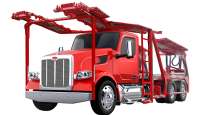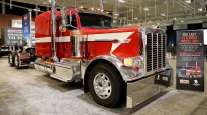Executive Editor
Peterbilt Plans to Craft Product Strategies to Meet Customer Demand

SCOTTSDALE, Ariz. — Peterbilt Motors Company is keeping an open mind toward innovation, as it explores various technologies and options for diversifying its product offerings in the years ahead, company executives said here.
“We’re looking at how do we provide the capability that our customers demand,” Kyle Quinn, general manager of Peterbilt, told Transport Topics. “It really comes down to how do they want to operate their fleets, and then we’ll make products and provide products that meet their requirements.”
Quinn and other Peterbilt executives were here to unveil the manufacturer’s new Model 579 UltraLoft sleeper, but in an exclusive interview with TT, discussed the company’s outlook for integrating emerging technologies into Peterbilt’s product offerings.
RELATED: Peterbilt unveils new sleeper design
Currently, the company is building 16 electric test trucks for use in Los Angeles County, and it is also developing an all-electric version of its M520 refuse truck that has an 80-mile range and is powered by a 400-horsepower electric motor. Quinn spotlighted these efforts in a presentation at the event, and told TT that as these technologies develop, their prospects to broader availability will increase.
“From an electric-vehicle perspective, there is still a ways to go,” he said. “Batteries, drive systems, control systems — all of those things are still evolving pretty rapidly. And the costs of them are still pretty significant. But the costs and the maturity of the technology are maturing quickly. As those mature, we’ll pursue them.”
But how the company chooses to pursue them is still an open question, noted Robert Woodall, Peterbilt’s assistant general manager for sales and marketing.
“Our philosophy is, there are lots of potential partners out there,” he said. “You probably have two different ways to go about it; you can either be a proprietary system that you hook your wagon to and say, ‘This is what we’re doing,’ or you can be an integrator. I think our approach right now is that, we are talking with a lot of different partners. We want to make sure that the technologies that make sense we can integrate into our product without necessarily picking one proprietary solution, and that’s it. We want to make sure that we’re talking with a number of people, and are able to integrate the best solutions into the product.”

Kyle Quinn by Joe Howard/Transport Topics
Quinn added, “That’s why we’re building the demonstrators and prototypes. We want to put those into customers’ hands and use them for a period of time, and give us the feedback and be able to measure their effectiveness. Through that we’ll really determine what changes need to be made to get them to the point where they’re market-viable.”
“When the market’s ready, and it makes economic sense, we’ll be ready,” added Peterbilt chief engineer Scott Newhouse.
Part of being ready will be having a service network in place, and Woodall noted that Peterbilt already has the infrastructure necessary to meet those needs.
“What might be difficult for some of those other non-OE is that you’ve got to have a network to take care of these things,” Woodall said. “The customer requirements around uptime, service and support is pretty demanding. What we know from new technologies is that it always puts a strain on the system. It’s important that you have a strong dealer network in place to be able to service that equipment. That is something we have, and that is going to give us an advantage as we move forward.”
Woodall pointed to the Peterbilt Technician Institute — an effort it launched with technical school UTI — to train service professionals for its dealerships. The initiative has already produced nearly 500 graduates, and could be a resource for training mechanics to work on next-generation vehicles. He noted that the company would like to expand the program to “drive technicians that are capable of meeting the challenges of all the new technology.”
Quinn noted that the service professionals entering the industry today are likely up to the challenge.
“Technicians are becoming more sophisticated,” he said. “The younger ones that are coming into the business today are more computer-savvy to start with, and they do become certified on the mechanical systems of the vehicles. But, they also need to have a good understanding of the electrical systems of the vehicle, and the embedded software. Those things all combine in the future — even moreso into that more advanced vehicle. So there is a growth curve associated with it. It is definitely a challenge.”




